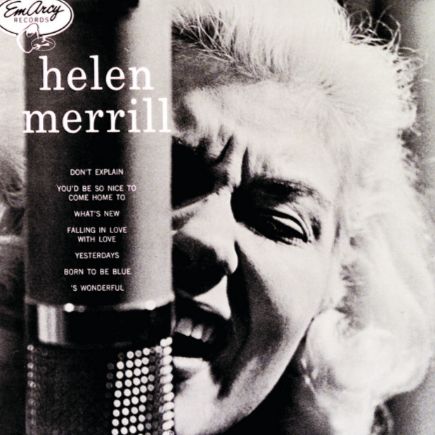You’d Be So Nice to Come Home To: entre mélancolie intime et résonance collective
Écrite en 1942 par Cole Porter pour le film Something to Shout About (1943), You’d Be So Nice to Come Home To fut immédiatement saluée, recevant une nomination à l’Oscar de la meilleure chanson originale. Pourtant, il faudra près d’une décennie pour qu’elle s’impose comme un véritable standard du jazz.
Porter y déploie l’élégance harmonique et la sophistication mélodique qui caractérisent son écriture. Le morceau se distingue par une ligne mélodique simple en apparence, mais riche en nuances et en inflexions expressives. Cette couleur légèrement mélancolique entre en tension productive avec le texte: une déclaration d’amour empreinte d’espoir, de désir et de promesse, qui trouve un écho profond dans le contexte de la Seconde Guerre mondiale.
En effet, You’d Be So Nice to Come Home To résonnait tout particulièrement auprès des soldats éloignés du front et de leurs proches restés à l’arrière. Les paroles, à la fois tendres et pleines d’attente, cristallisent le rêve universel du retour, du lien retrouvé, de la chaleur humaine face aux incertitudes du temps présent.
Un duo suspendu entre douceur et intensité
Enregistrée à New York les 22 et 24 décembre 1954 pour l’album Helen Merrill, la version de You’d Be So Nice to Come Home To illustre à merveille la rencontre entre la jeunesse audacieuse d’Helen Merrill et la virtuosité poétique du trompettiste Clifford Brown.
Helen Merrill y impose un style déjà accompli: voix légèrement voilée, phrasé précis, expressivité contenue. Son approche se distingue par un équilibre subtil entre spontanéité et maîtrise, un art du chant qui privilégie la couleur et la respiration.
Le sextette qui l’accompagne crée un écrin sonore d’une grande finesse. La trompette de Clifford Brown ne se contente pas de ponctuer le chant, elle le prolonge, en dialogue constant. La flûte de Danny Bank apporte une touche aérienne, le piano de Jimmy Jones tisse une trame harmonique fluide, tandis que la guitare claire de Barry Galbraith ajoute un contrepoint délicat. Milt Hinton et Osie Johnson assurent un ancrage rythmique d’une souplesse exemplaire, donnant à l’ensemble une respiration naturelle.
You’d Be So Nice to Come Home To: entre melancolía íntima y resonancia colectiva
Escrita en 1942 por Cole Porter para la película Something to Shout About (1943), You’d Be So Nice to Come Home To fue aclamada de inmediato y recibió una nominación al Óscar a la mejor canción original. Sin embargo, pasarían casi diez años antes de que se consolidara como un verdadero estándar del jazz.
Porter despliega en ella la elegancia armónica y la sofisticación melódica que caracterizan su escritura. La pieza destaca por una línea melódica en apariencia sencilla, pero rica en matices e inflexiones expresivas. Esta coloración ligeramente melancólica entra en tensión fecunda con el texto: una declaración de amor cargada de esperanza, deseo y promesa, que halló un eco profundo en el contexto de la Segunda Guerra Mundial.
En efecto, You’d Be So Nice to Come Home To resonaba especialmente entre los soldados lejos del frente y sus seres queridos que esperaban en casa. La letra, tierna y llena de anhelo, cristaliza el sueño universal del regreso, del reencuentro, del calor humano frente a las incertidumbres del presente.
Un dúo suspendido entre dulzura e intensidad
Grabada en Nueva York los días 22 y 24 de diciembre de 1954 para el álbum Helen Merrill, la versión de You’d Be So Nice to Come Home To ilustra de manera ejemplar el encuentro entre la juventud audaz de Helen Merrill y la virtuosidad poética del trompetista Clifford Brown.
Helen Merrill impone aquí un estilo ya maduro: una voz ligeramente velada, un fraseo preciso y una expresividad contenida. Su interpretación se distingue por un equilibrio sutil entre espontaneidad y control, un arte del canto que privilegia el color y la respiración.
El sexteto que la acompaña crea un marco sonoro de gran refinamiento. La trompeta de Clifford Brown no se limita a acompañar la voz, sino que la prolonga en un diálogo constante. La flauta de Danny Bank aporta un toque aéreo, el piano de Jimmy Jones teje una trama armónica fluida, mientras que la guitarra clara de Barry Galbraith añade un contrapunto delicado. Milt Hinton y Osie Johnson garantizan una base rítmica de una flexibilidad ejemplar, otorgando al conjunto una respiración natural.
You’d Be So Nice to Come Home To: tra malinconia intima e risonanza collettiva
Scritta nel 1942 da Cole Porter per il film Something to Shout About (1943), You’d Be So Nice to Come Home To fu subito accolta con favore e ricevette una nomination all’Oscar per la miglior canzone originale. Tuttavia, ci vorrà quasi un decennio prima che venga riconosciuta come un vero standard del jazz.
Porter vi dispiega tutta l’eleganza armonica e la raffinatezza melodica che contraddistinguono la sua scrittura. Il brano si distingue per una linea melodica apparentemente semplice, ma ricca di sfumature e inflessioni espressive. Questo colore lievemente malinconico entra in tensione fertile con il testo: una dichiarazione d’amore intrisa di speranza, desiderio e promessa, che trova un’eco profonda nel contesto della Seconda guerra mondiale.
You’d Be So Nice to Come Home To risuonava infatti in modo particolare tra i soldati lontani dal fronte e i loro cari rimasti a casa. Il testo, tenero e colmo d’attesa, cristallizza il sogno universale del ritorno, del ricongiungimento, del calore umano di fronte alle incertezze del tempo presente.
Un duo sospeso tra dolcezza e intensità
Registrata a New York il 22 e 24 dicembre 1954 per l’album Helen Merrill, la versione di You’d Be So Nice to Come Home To rappresenta alla perfezione l’incontro tra la giovinezza audace di Helen Merrill e la virtuosità poetica del trombettista Clifford Brown.
Helen Merrill impone qui uno stile già compiuto: voce leggermente velata, fraseggio preciso ed espressività contenuta. La sua interpretazione si distingue per un equilibrio sottile tra spontaneità e controllo, un’arte del canto che privilegia il colore e il respiro.
Il sestetto che la accompagna crea una cornice sonora di grande finezza. La tromba di Clifford Brown non si limita a sottolineare il canto, ma lo prolunga in un dialogo costante. Il flauto di Danny Bank aggiunge un tocco aereo, il pianoforte di Jimmy Jones intreccia una trama armonica fluida, mentre la chitarra limpida di Barry Galbraith porta un controcanto delicato. Milt Hinton e Osie Johnson garantiscono un ancoraggio ritmico di straordinaria morbidezza, conferendo all’insieme una respirazione naturale.
You’d Be So Nice to Come Home To: between intimate melancholy and collective resonance
Written in 1942 by Cole Porter for the film Something to Shout About (1943), You’d Be So Nice to Come Home To was immediately acclaimed, earning an Academy Award nomination for Best Original Song. Yet it would take nearly a decade for it to establish itself as a true jazz standard.
Porter displays here the harmonic elegance and melodic sophistication that define his writing. The piece is marked by a seemingly simple melodic line, rich in nuance and expressive inflection. Its slightly melancholic tone creates a productive tension with the lyrics—a declaration of love filled with hope, longing, and promise—which resonated deeply during the Second World War.
Indeed, You’d Be So Nice to Come Home To struck a particular chord with soldiers far from home and the loved ones waiting for their return. The lyrics, both tender and full of yearning, crystallize a universal dream: the hope of return, of reunion, of human warmth in uncertain times.
A duo suspended between tenderness and intensity
Recorded in New York on December 22 and 24, 1954 for the album Helen Merrill, this version of You’d Be So Nice to Come Home To perfectly captures the encounter between Helen Merrill’s youthful boldness and the poetic virtuosity of trumpeter Clifford Brown.
Helen Merrill displays a fully formed style: a slightly husky tone, precise phrasing, and a restrained expressiveness. Her interpretation stands out for its delicate balance between spontaneity and control—an art of singing that values color and breath above all.
The sextet accompanying her creates a sonic setting of remarkable finesse. Clifford Brown’s trumpet does more than punctuate the vocals—it extends them, engaging in an ongoing dialogue. Danny Bank’s flute adds an airy touch, Jimmy Jones’s piano weaves a fluid harmonic texture, while Barry Galbraith’s clear guitar brings a gentle counterpoint. Milt Hinton and Osie Johnson provide an exemplary rhythmic foundation, giving the ensemble an effortless, natural flow.


